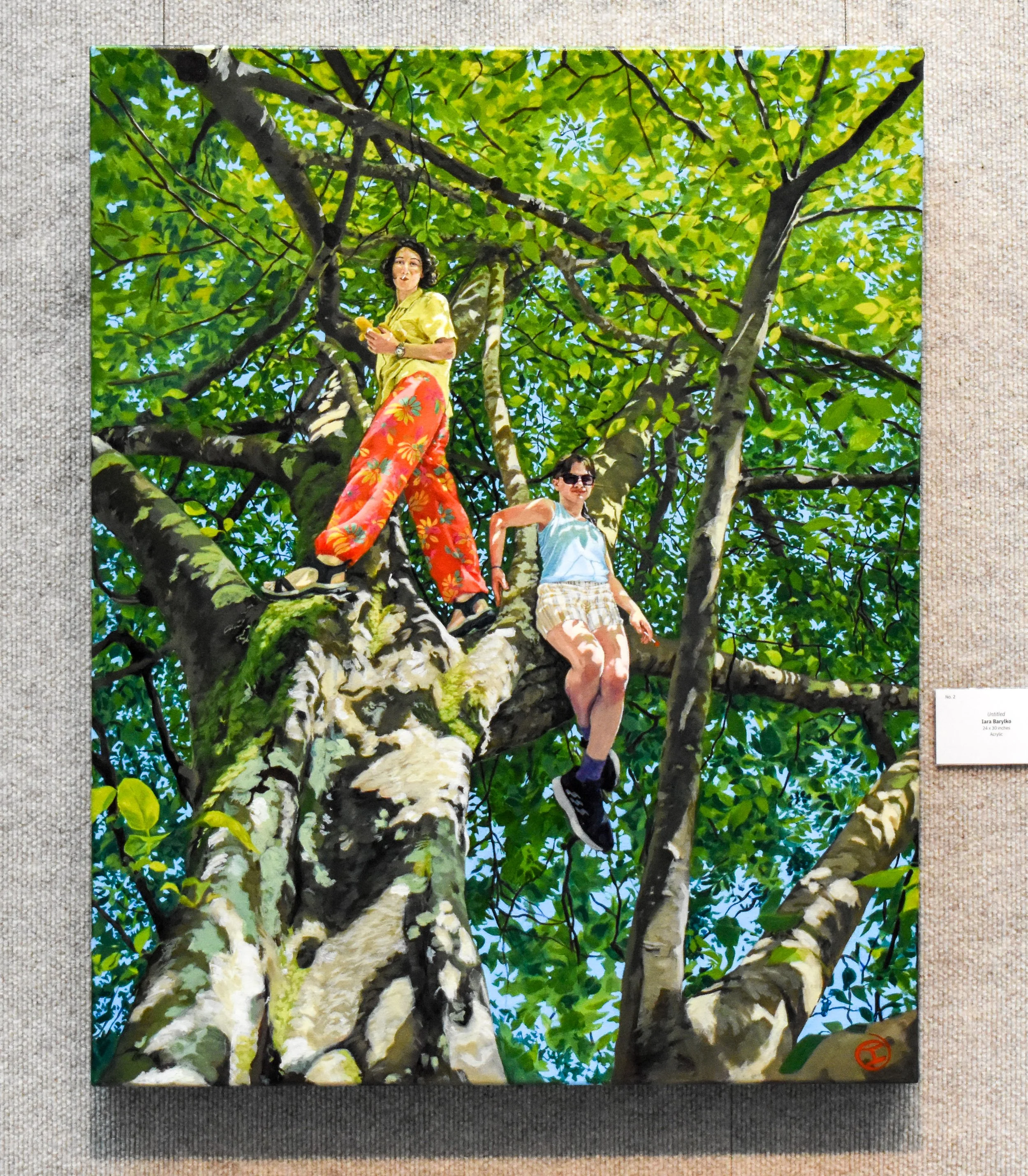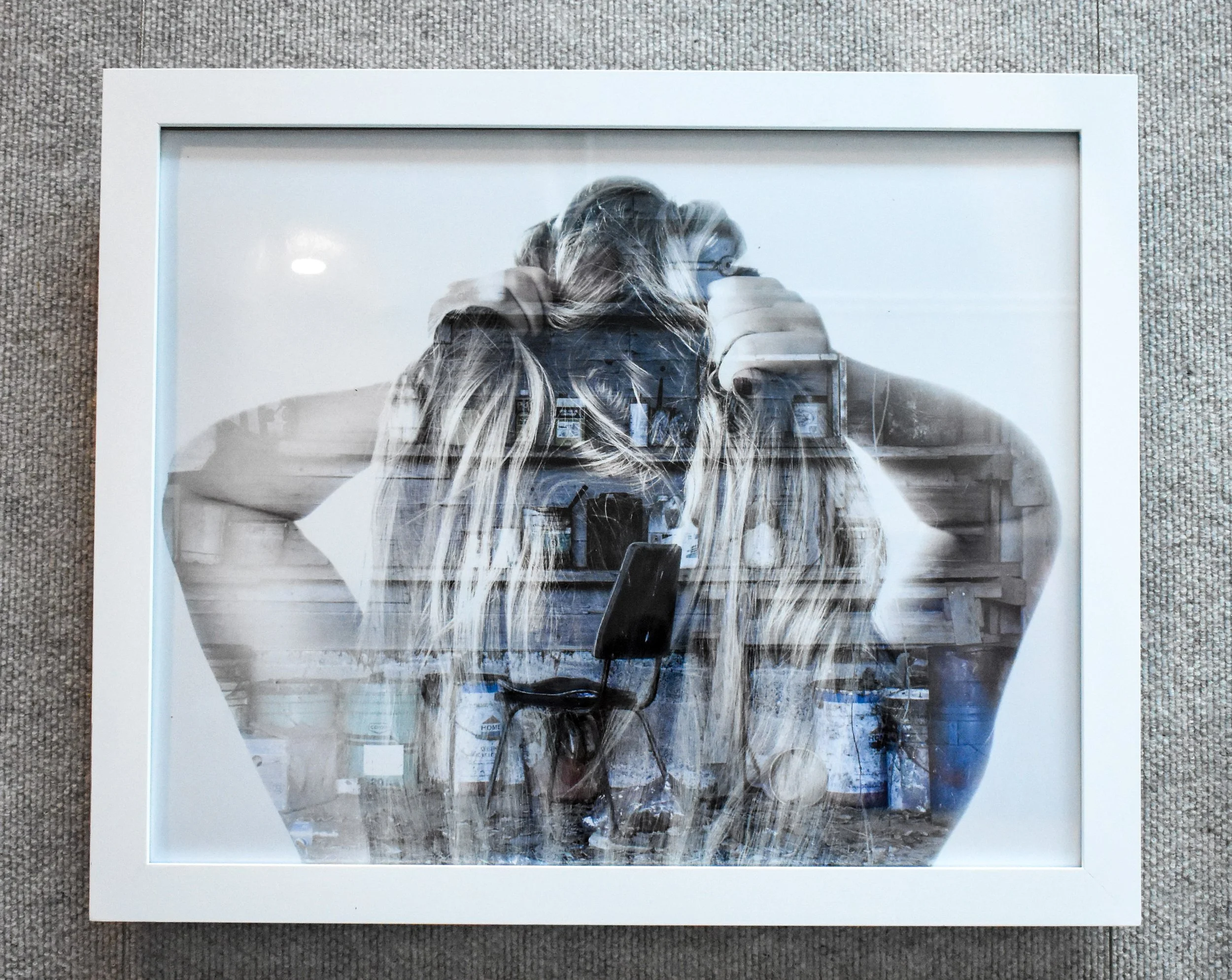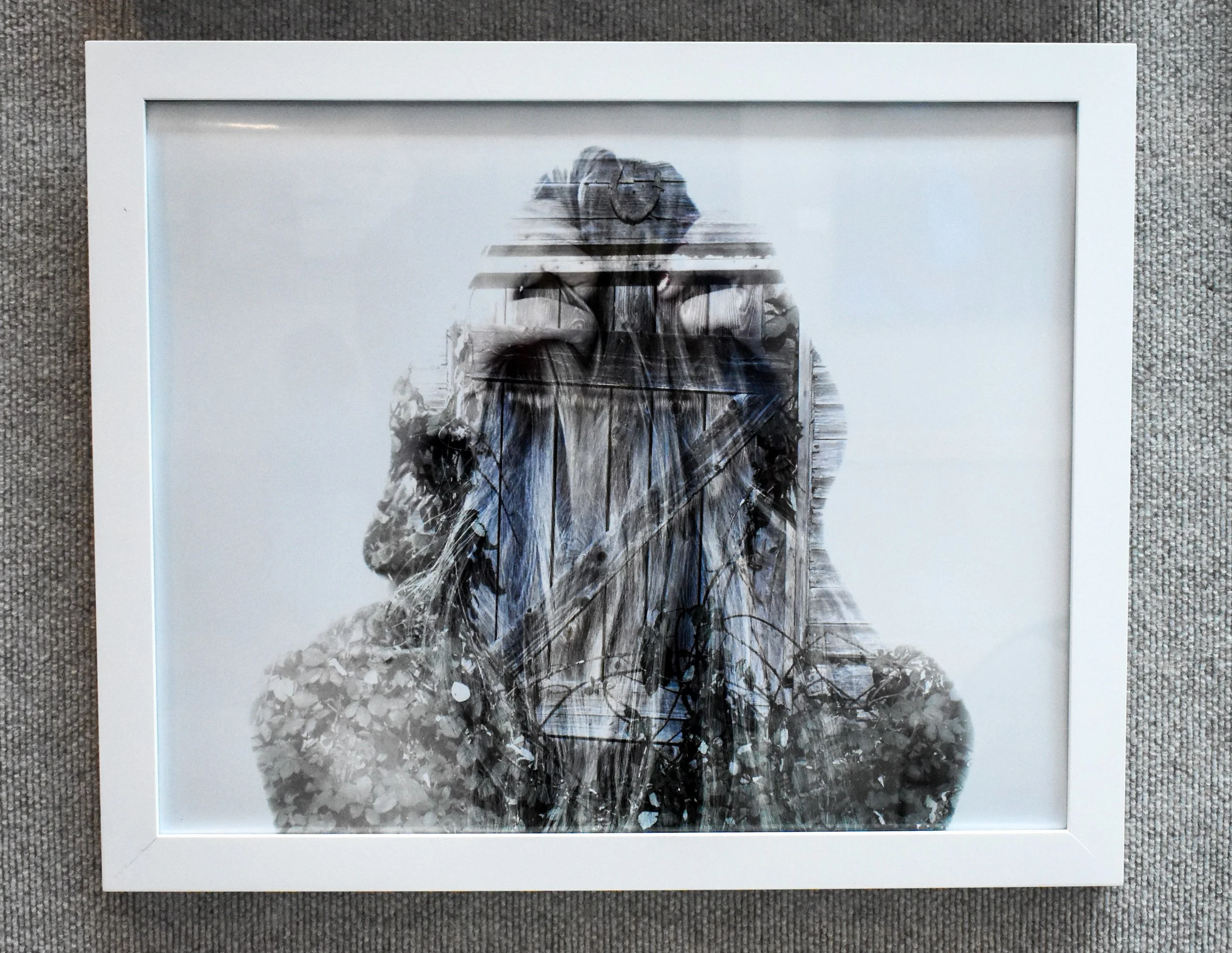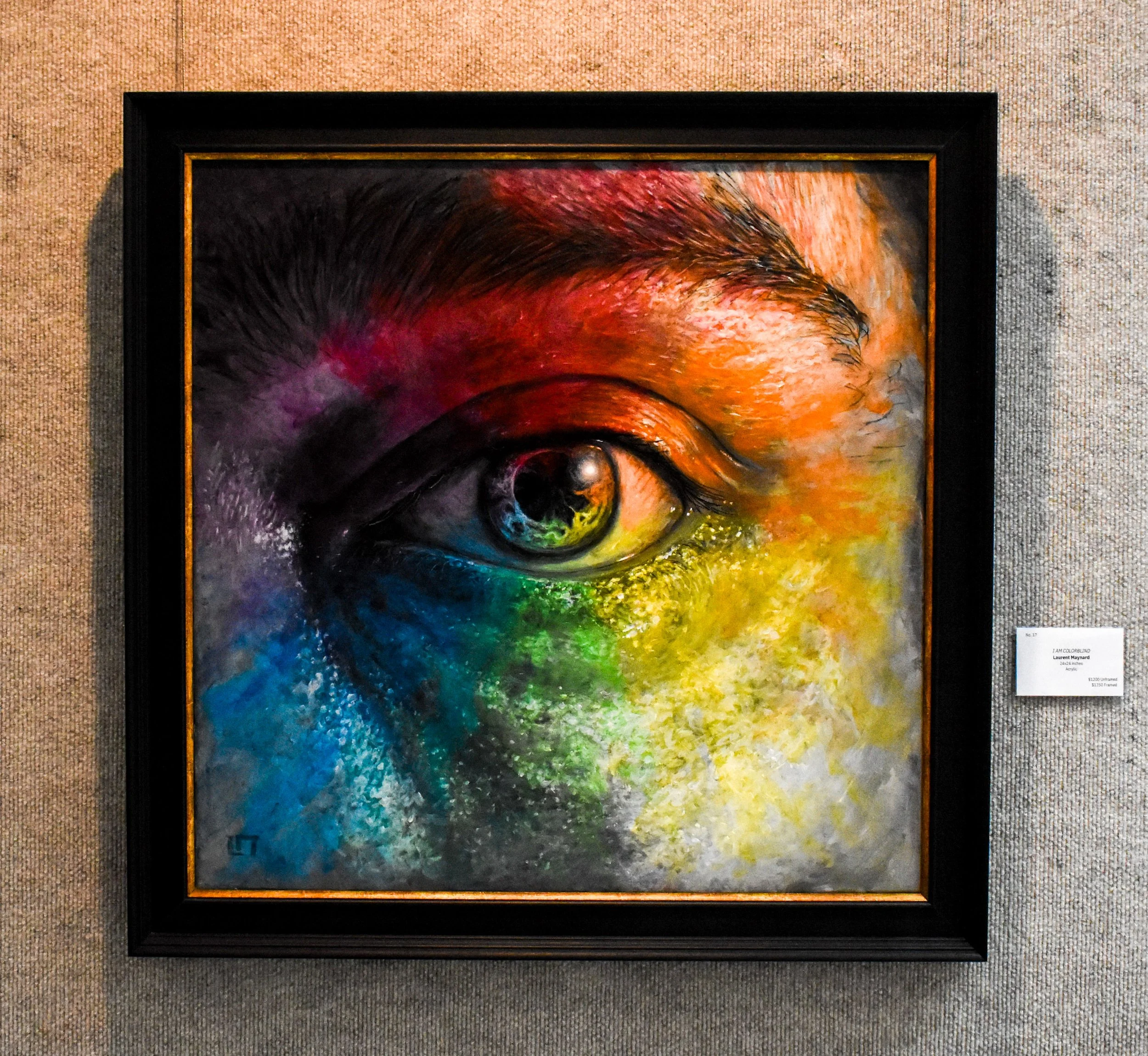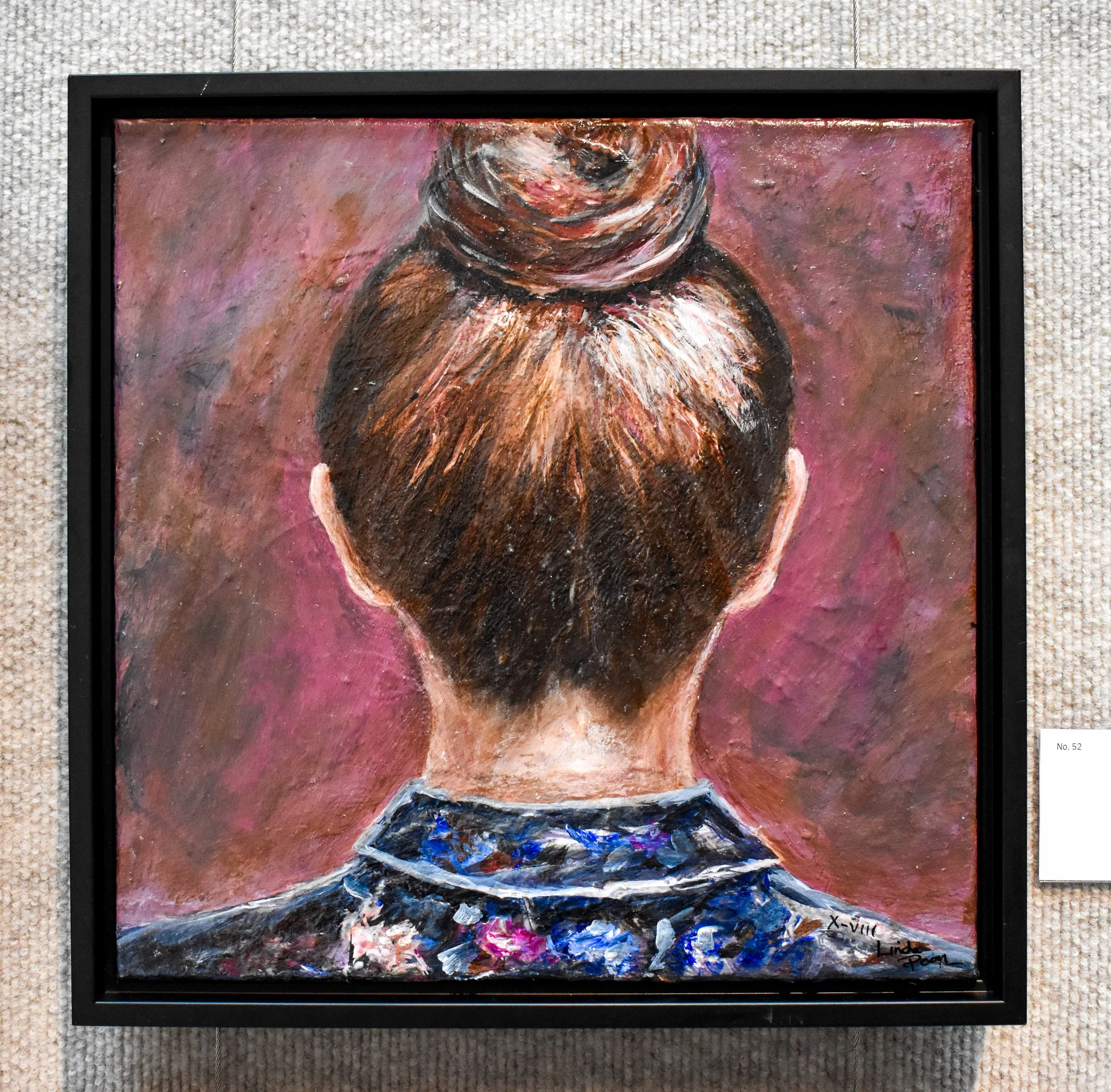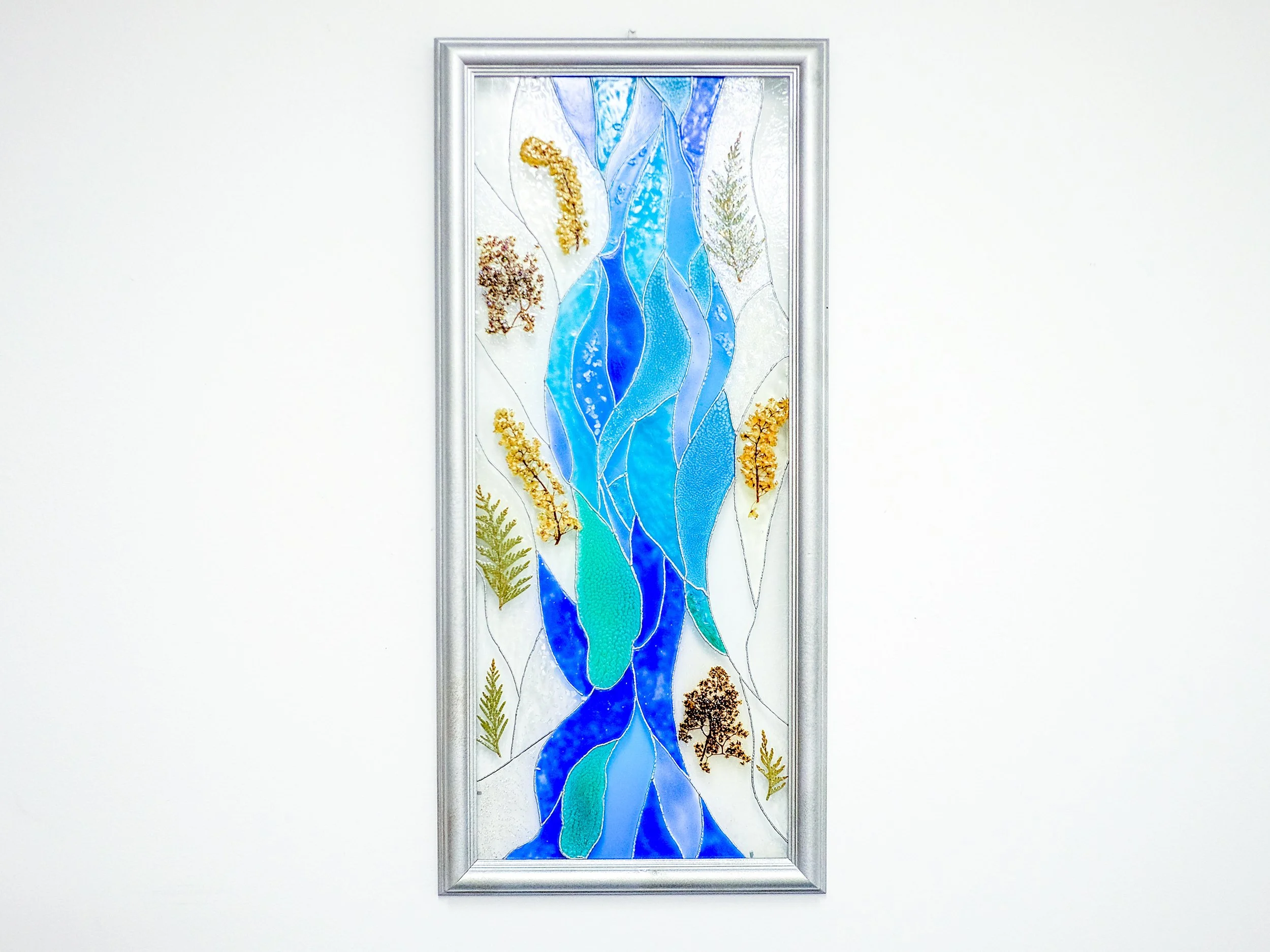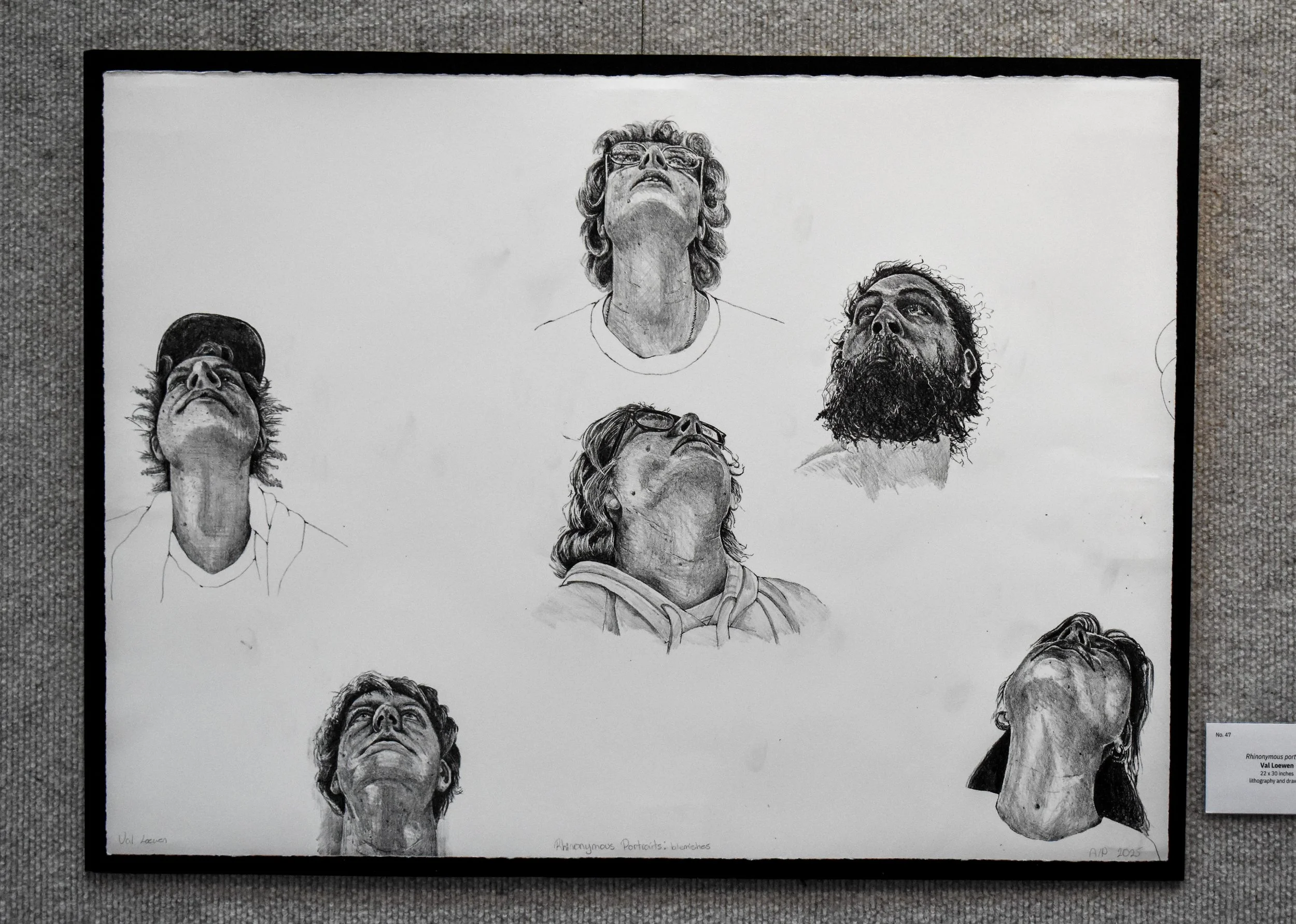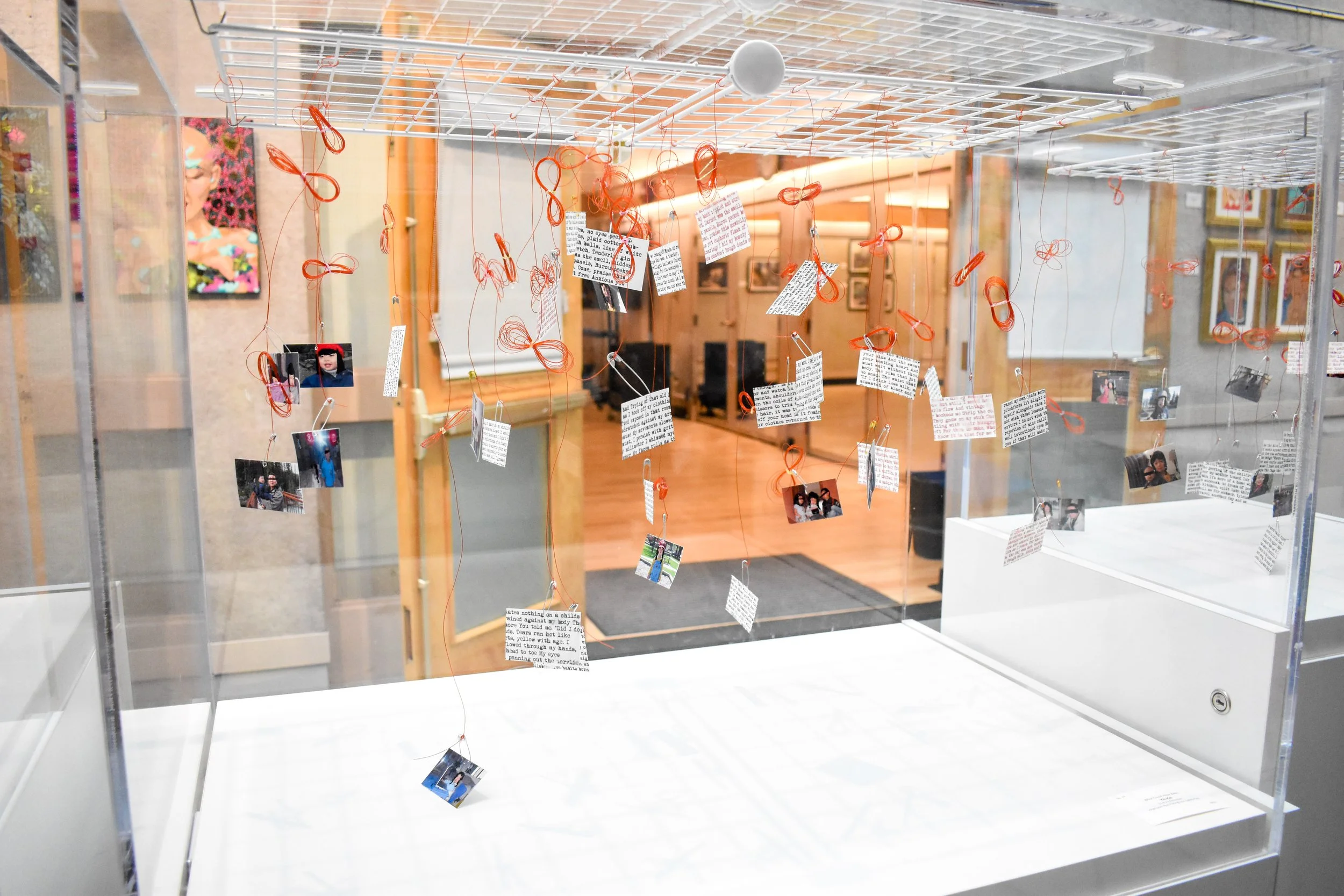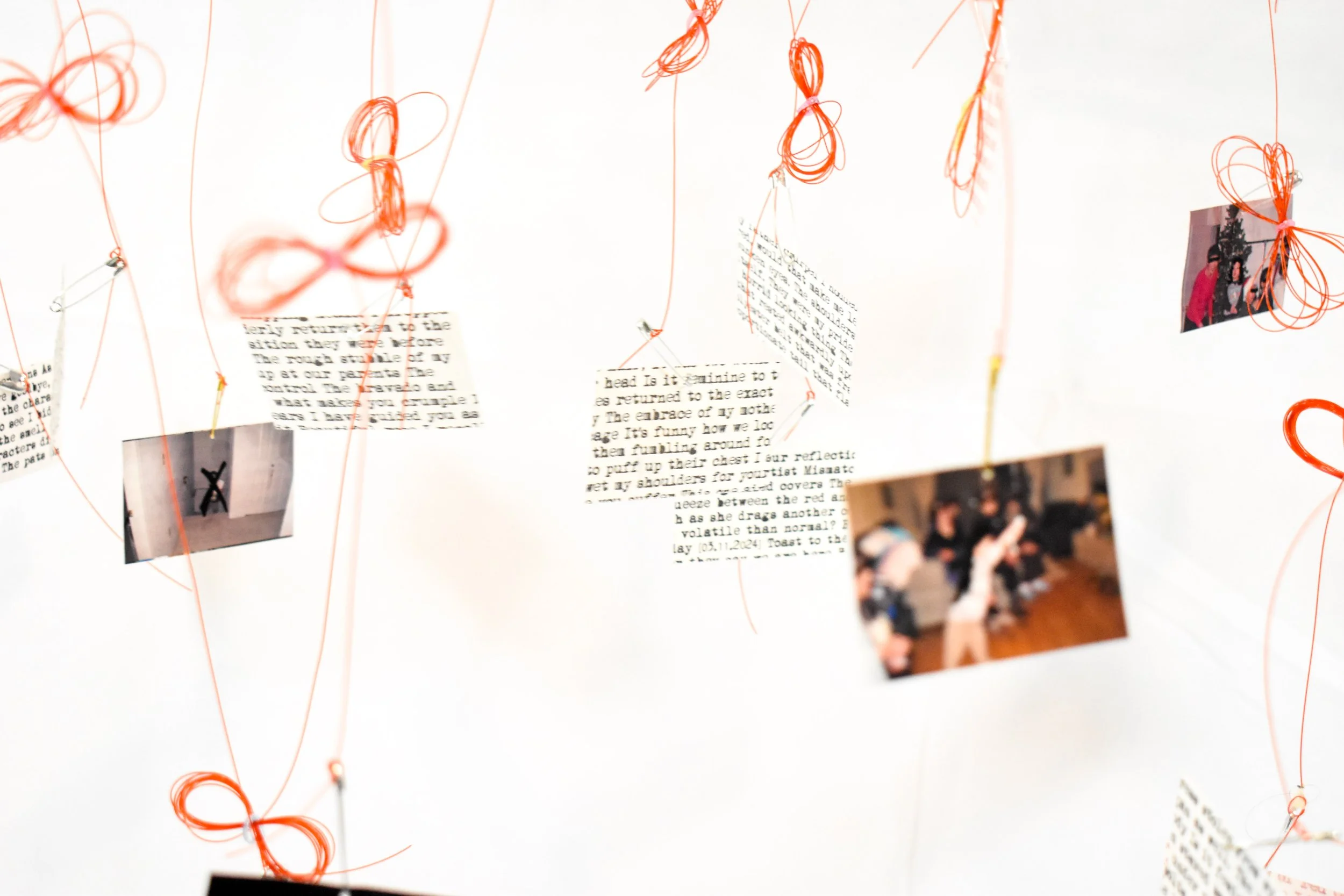
Your Image
This multi-medium art exhibit showcases works by community members that speak to identity, culture, self-expression, and/or the perception of ourselves or others.
Farzaneh Mohammadian
-
I was born in 1987 in Iran, and my painting style mainly blends elements of expressionism, post-impressionism, and surrealism. Through my work, I try to explore genuine human emotions, including themes of struggle and resilience. I primarily use oil or acrylic on canvas as my medium.
Roots of Freedom is a portrait of Mahsa Amini, a 22-year-old Iranian woman whose tragic death in 2022 under the pressure of the religious morality police of Iran’s government, sparked widespread protests against mandatory hijab laws and she became a symbol of women’s rights and freedom in Iran. Since then, many women and human rights activists (not limited to Iranians) have been advocating for the restoration of women’s autonomy over their bodies and hair (fundamental aspects of one’s identity), through movements such as Woman, Life, Freedom.This piece depicts Mahsa’s hair flowing in the wind, transforming into tree branches with young green leaves, symbolizing the young green movements shaped and named after her.
Iara Barylko
-
Iara is a multidisciplinary artist based in Maple Ridge, the traditional territories of the Katzie (q̓ic̓əy̓) and Kwantlen(qʼʷa:n̓ƛʼən̓) First Nations.
They graduated from Emily Carr University of Art+Design with a Bachelors of Fine Art, with a focus in illustration. Using acrylic, oil, watercolour, graphite, digital, clay, and many more mediums, Iara creates colourful narrative work filled with movement which captures moments of life around them.
Jasmine Kadija
Jeeva Thomas
-
I am a Canadian abstract painter based out of Vancouver, BC. These are my self-taught, and initially learned to paint as an escape from illness (cancer); in the process, I discovered an overwhelming passion and appreciation for artistic expression. I am a native of Trincomalee, Sri Lanka, and a long-time resident of Paris, France, my paintings reflect my life journey from island to urban city, to mountainous terrain. Through vivid colors and knife strokes, I hope to celebrate the world and my experiences that both shape and inspire me as an artist.
Jeidn Winkler
-
Jeidn Winkkler is a Czech artist based in Vancouver whose work delves into the complexities of identity and subjectivity, informed by personal experiences of living with Borderline Personality Disorder (BPD). Through mediums such as colored pencils, acrylic paint, and photography, Winkler transforms internal struggles into tangible works of art that explore themes of self-perception, vulnerability, and resilience.
A graduate of the University of British Columbia with a Bachelor of Fine Arts with Distinction (2024), Winkler has exhibited extensively across Canada. Their works have been featured in a variety of exhibitions such as the ArtSpacific Competition and Exhibition (2024), Kate Craigslist: Occurs and Reoccurs at the Hatch Gallery, and several of UBC’s undergraduate exhibitions at the AHVA Gallery. Their artistic exploration has also been recognized in publications like the UJAH 15th Edition and Coin-Operated Press’ Queer Photography Zine.
As a non-binary and queer artist, Winkler often navigates intersections of cultural heritage, gender identity, and the impact of technology in shaping modern subjectivities. Their practice is deeply rooted in self-portraiture, allowing them to historicize fragments of their ever-evolving identity while fostering a dialogue around often challenging and controversial topics. Through this, they invite viewers to reflect on their own experiences and engage in a shared exploration of identity and selfhood.
By capturing the fluidity of identity and turning pain into art, Winkler creates works that not only deepen their understanding of themselves but also resonate profoundly with diverse audiences. They continue to explore these themes with an unwavering commitment to authenticity and emotional expression.
Jennifer Shepit
-
Jennifer Shepit is a painter in British Columbia, living in Abbotsford with her husband and son, working from a home studio since graduating from UFV with a Visual Arts Diploma in 2005.
Drawing inspiration from her every day surroundings, nature, people, and mundane interactions, she works primarily in oil and watercolour, but is always excited to experiment with new media.
Her current work has been an exploration of things such as how she experiences the changing landscape and places around her in relation to memory, the impact of the medicalization of the disabled body, and how we each experience our own unique inner world of senses and conceptual processing.
Jennifer has always appreciated how paint, colour, and movement allow her to speak without words.
Jenny Zhang
-
Jenny Zheng is a painter, illustrator, and workshop facilitator whose work explores identity, mental health, and cultural connection. As a Chinese-Canadian artist and a child of immigrants, Jenny grew up navigating the intersections of heritage and self-expression in a Western world. Their art blends vibrant murals, digital illustrations, and paintings that fuse playfulness with spirituality, drawing from personal experiences with neurodivergence and healing. Through their work, Jenny aims to create spaces for reflection, empowerment, and community, using art as a bridge between past and present, tradition and transformation.
https://www.cozyconnections.ca/
@cozyconnectionstudio
Khim Mata Hipol
-
Portraityal is a series of self-portrait images that creatively explore Filipino idiomatic expressions. Each piece in this project visually interprets a specific phrase, capturing its unique cultural essence. Filipino idiomatic expressions are distinct in how they reflect and playfully poke fun at Filipino culture, often centring around childhood upbringing, street language, and everyday life. While these phrases can humorously describe individuals, they also offer insight into daily experiences. Through Portraityal, playful gestures and expressive self-portraits bring the vibrant meanings of these idioms to life, transforming language into vivid visual storytelling.
Kim Brake
-
As a breast cancer survivor and a woman living with alopecia, Kim has faced wounds around what society often deems feminine. Her expansive exploration of feminine energy reveals so much more. She has since embraced radical self love and a life lived with authenticity.
Kim is well known for her painted goddess series which has been one of many outlets to reclaiming her feminine energy. In the medium of acrylics on canvas, she paints colorful goddesses often dressed in costumes and fashion infused with elements of nature. Her work has recently shifted from inner reflection to bold self-portraits and women with eyes wide open.
As a multi-disciplinary artist, Kim has self published her own book of haiku, This Journey of Mine and has collaborated with other writers and artists to curate and create five anthologies. In 2024 Kim’s art was featured at the Vancouver Outsider Arts Festival and the Vancouver Under 100 Art Show. She also presented as feature artist for Surrey Muse. In 2025 she looks forward to new experiences and challenging herself beyond her comfort zone.
Kiran Sonea
-
This piece is about race and ethnicity, fighting for a sense of belonging and speaking to the immigrant feeling of in-betweenness. It can evolve to adopt different combinations of coloured gel filters and semiotic symbols.
This piece reflects my journey of self-acceptance, from hiding behind flawless makeup and a polished façade to feel seen, to embracing my clumsy, imperfect self.
Krystal Charlston
-
My artwork explores the intimate relationship between personal identity and the environment we inhabit. Using the technique of double exposure, I combine portraits of myself with images of the farmland I live on, creating a visual dialogue between the body and the land. By layering the natural landscape within the contours of my figure, I reflect on how place and identity are intertwined—how the land shapes us as much as we shape it.
In each piece, I face away from the viewer, leaving my identity ambiguous and inviting the audience to reflect on the broader themes of anonymity and self-representation. This intentional lack of direct eye contact fosters a sense of distance, challenging the viewer to look beyond the individual and focus on the layers of meaning within the work. The stark white background enhances this feeling of isolation, emphasizing the tension between the self and the external world.
The farmland in the composition serves as both a literal and metaphorical representation of my connection to my roots, yet the abstraction of the double exposure renders the land and the figure as one. This blurring of boundaries between person and place highlights the fluidity of identity in rural environments, where self-expression is often rooted in, but not limited to, one’s surroundings.
By using myself as the subject, I aim to oIer a personal reflection on how identity is shaped by both internal and external forces, while also prompting a broader conversation about how we perceive and present ourselves in the context of our environment. This work challenges conventional notions of self-portraiture by presenting the figure as both part of, and distinct from, the landscape—a reflection on how our environment and cultural narratives inform the way we perceive ourselves and are perceived by others.
Laurent Maynard
-
"I AM COLORBLIND" is a powerful self-portrait that delves into the artist's personal journey with color perception. At the center of the piece, the artist's eye is surrounded by a radial gradient of colors from the primary and secondary colors, creating a vibrant and dynamic visual effect.
This striking composition serves as a metaphor for the artist's experience with colorblindness. Despite living with this condition for over three decades, the artist had kept it hidden from the world. This painting represents a moment of revelation, as the artist chooses to openly express and share their unique perspective.
The juxtaposition of the colorful background against the singular focus on the eye creates a sense of tension and introspection. It invites viewers to contemplate the relationship between perception, identity, and the way we see the world.
By sharing this intimate detail through art, the creator opens up a dialogue about acceptance, visibility, and the beauty found in differences. This piece encourages us to embrace our unique perspectives and to celebrate the diversity of human experience.
Linda Poon
-
My Series ‘Identity Through Hairstyle’ show different ways in which women wear their hair today. I am intrigued by the ways women experiment with different styles to represent their identities. Whether it be through length, colour, highlights, hair buns, braids, ponytails, and the like; hairstyles are an extension of one’s personality.
The inspiration for the pieces was my curiosity around various ways we express our personal identity – when allowed to feel free to be who we want to be and show it. Hairstyles can be a fun and healthy way to express ourselves.
The Series, started in 2024, uses mixed media acrylics; I currently have 5 pieces in the series and will continue adding to the collection.
Lynda Smith
-
A self-employed creator, Lynda Smith, is passionate about growing food, teaching gardening, exploring new artistic avenues and writing about her life adventures. In 2021, she relocated closer to an expanding family (now a grandmother to 8 wonderful children), which is when she started Junco Studio Art & Upcycling in Westwood Plateau. Lynda promotes = #insteading - a lifestyle where one actively chooses to grow, nurture, upcycle and beautify with available materials instead of purchasing new ones. She is a frequent artisan vendor at local Farmers' Markets. Read her food growing blog at www.lawntofood.com and follow her art adventures on Facebook Junco Studio or Instagram @junco.studio
Martha and Lina
-
Martha and Lina, a couple of two immigrant Colombian amateur artists in their 40’s who use writing and photography as tools to express and explore the deeply emotional and personal journey of migration. Their work focuses on the complex experiences of individuals navigating identity, community, and self-expression in unfamiliar environments. Through their unique blend of photography and written word, they examine how immigrants perceive themselves in relation to new communities and how these perceptions shape their visual representation and sense of belonging.
Martha and Lina present a series of photographs with embedded written reflections that delve into the intersection of immigration and identity. Their pieces explore the often invisible and deeply emotional experiences of adapting to a new environment, focusing on the fragments of identity immigrants carry with them. By capturing what immigrants see through their eyes, they offer a window into the diverse ways in which immigrant identities are shaped and reshaped through cultural expression, social integration, and the struggle to maintain heritage while embracing new surroundings.
Melody Fowler
-
Born in Vancouver, BC, Melody began her artistic journey in 2020, at the surprisingly tender age of 54. She is an author and after completing her 2nd book, burnt out from writing she was in need a creative outlet— she picked up a brush. She quickly discovered she had a talent for capturing people and wildlife on canvas. Raised in the diverse community of East Vancouver and marrying into a black family, she was moved to capture the colour and rich culture that surrounded her. Her art has gained recognition with commissioned pieces showcased in homes and businesses in Canada and the US.
Nayeon (Michelle) Hong
-
“Disobedience (2024)” is a performance-based photography project in my ambitious investigation to connect yellow with Korean identity. I was born and raised in South Korea until I was 16. My family abruptly immigrated to Canada without the ability to speak English fluently. The unexpected immigration caused me tremendous trauma, and I was unwilling to talk and live in a new environment. Within this distressing trauma like the language barrier and bullied from others, I feel discouraged thinking of a weak existence. From harassing thoughts, I wanted to reveal my toughness through my body gestures as an artwork. I explored my hostility in my inner mind in the term “disobedience”. Disobedience has significant meanings in white Hanbok, the colour yellow and body gesture performance.
I recognize the Korean traditional white clothing “Hanbok(한복)” as a symbol of resistance (Lee 1). Not only does the Hanbok represent my identity of cultural conditioning, but it also symbolizes Korean ethnonationalism. White Hanbok represents purity with the aesthetic value itself. The shape of the Hanbok contains beautiful lines but implies a compliant figure of a woman. Because of the sensorial properties of the Hanbok, the Japanese attempted to eliminate white Hanbok during Japanese colonization in 1910 (Lee 7). From that, I observe defiant strength from colonized society. I chose Hanbok to represent tenacity from toughness and encounter the history of Koreans trying to preserve their clothing.
“Disobedience (2024)” investigates the yellow colour in my experimentations. I face stereotypes in my contemporary life. Go to a university, have a job, and make tremendous money to be successful. I observe these trite thoughts as yellow because they recognize a warning colour that coexists with a passive, static gesture (Cardullo 191). Yellow was also associated with jealousy, envy and hatred, related to a medieval theory of humor (Costantini 584). Yellow easily smudges into my life without notice, even if I do not have an opinion. I try to investigate the track of losing voice by brushing yellow to the background towards the 3 subject. I explore the yellow building on my body movements and gestures. With my hand and foot, I confront the raw face of social pain. By painting yellow directly with my hands and feet and brushing on a white background, I convey the dynamicity of my feelings towards subservient conditions.
Nishi Banipal
-
This painting explores the parallel yet distinct journeys of a Sikh father and son, united by their heritage but shaped by different cultural experiences. The father, born in Punjab and coming to Canada in the 1970s, initially cut his hair to conform and secure a job in a foreign land. The son, born in Canada, followed a similar path of cutting his hair in order to fit in, navigating the complexities of growing up between two worlds.
In the center of the composition sits the father, now retired, who has once again embraced his turban, a symbol of pride, resilience, and reclaiming his identity. His face reflects the deep satisfaction of returning to his roots, having transcended the pressures of assimilation. Surrounding him are portraits of the father and son at different stages with their hair—each representing the internal and external struggles of maintaining cultural integrity while adapting to their environment.
The painting highlights themes of identity, transformation, and generational difference, while underscoring the significance of reclaiming one’s heritage. It shows the different feelings and experiences that both men have with a similar journey. One feeling more like himself when he cut his hair, and the other when he returned to wearing a turban. The painting composition aims to mimic a family portrait, and the pictures on the wall behind them showcase the ancestors, whose stories, hopes and expectations are woven into the stories of the men depicted in the front.
The subjects of this painting are my father and brother. Having witnessed their struggles, I wanted to showcase a mens issue that is seldom given spotlight. I recall the pain in my Dad’s voice when he spoke of the man he used to be, and then seeing the pride with which he chooses his turbans now. On the other hand I remember my brother begging to be able to cut his hair, and how badly he wanted to try the hairstyles the boys on TV had. The little fountain of a topknot that he was so fond of as a toddler, was now making him feel like he didn’t belong. I felt his guilt and shame for wanting to cut the hair, that my mom so loving combed and braided for him, but knew he would only be keeping it for my parents, if he didn’t cut it.
Oxana Baydina
-
Golden Blaze
"Golden Blaze" is an abstract stained glass piece that intricately weaves hidden symbols into its fiery red and gold composition. Utilizing specialty paints, this artwork subtly integrates images of a horse’s head, a horn, the sun, butterfly wings, and a fish. The vibrant palette and the play of light through the glass create a dynamic and intriguing visual experience, inviting viewers to discover and interpret the hidden elements within the blazing colors. Framed and ready to be a striking centerpiece, this piece blends modern artistic flair with symbolic depth.
The Flow of Identity: Water and Hair in Stained Glass
Through its depiction of fluid motion, this artwork beautifully intertwines the imagery of water and the symbolic essence of women's hair, exploring themes of identity, self-expression, and perception.
Hair, much like water, is a defining aspect of personal and cultural identity. It flows, transforms, and interacts with its environment, much like the tides of an ocean. The undulating blue forms in this stained glass composition evoke the natural movement of water, reminiscent of hair caught in the wind or cascading in soft waves. This visual metaphor bridges the physical and emotional aspects of self-expression, emphasizing the fluid, adaptable nature of identity.
In many cultures, women's hair is laden with meaning—it can signify beauty, strength, tradition, or rebellion. Similarly, water carries universal symbolism as a source of life, renewal, and emotional depth. By connecting these two elements, the artwork reflects the duality of hair as both a physical feature and a vessel of personal and cultural narratives. It invites viewers to consider how hair, like water, shapes how we see ourselves and how others perceive us.
The inclusion of natural textures within the glass—leaves and other organic forms—further enriches the connection between body and environment. Just as water nourishes and shapes the land, hair often interacts with and is influenced by nature. This interplay reminds us that our identities are not isolated but exist within a broader context, constantly shaped by the physical and cultural landscapes around us.
A Portrait of My Husband: Identity Through Stained Glass
This stained glass portrait of my husband is a deeply personal exploration of his character and essence. The fractured shapes and vibrant colors reflect the complexity of his identity—strength, warmth, and introspection. Each piece of glass captures an aspect of his personality, blending together to form a cohesive whole, just as the layers of identity are shaped by life’s experiences.
The dynamic interplay of light and shadow adds depth, symbolizing the dualities of human nature—resilience and vulnerability, outward presence and inner thought. Through the abstract composition, this piece goes beyond physical likeness to celebrate his individuality and the enduring connection we share.
This portrait, crafted with care and love, serves as both a tribute to him and a reflection on the multifaceted nature of identity, reminding us of the beauty found in every unique human story.
Puneet Datewas
-
Puneet is a Vancouver based an artist and an art educator. Before moving to Canada, she spent her childhood playing with paint in her mom’s art studio in Chandigarh, India; a city hugged by mountains and inspired by Swiss & French architecture. Puneet holds a BA in Geography from the University of Victoria. After completing her degree, she pursued her love for art at Canvas Method - a contemporary atelier. She currently works for the City of Surrey as an art instructor while developing her art practice out of her studio in Eastside Atelier.
Ranu Chakraborty
-
Born and brought up in a remote town in India, Ranu Chakraborty was always very passionate about art. Living far from a city, it was hard for her to pursue art college education. But with love for her art and her dream, she graduated in Fine Art from the Govt, College of Art,India,with a first class rank and started following her dream of becoming an independent artist. She also recently completed a Diploma in Animation Concept Art from the prestigious Vancouver Film School. It has been more than 15 years since she has been working as an artist in India, and now in Canada.
In time, she was introduced to paper sculpture as a medium of art. It gave a new direction to her pursuit of art. As a medium, it is something so unique, so delicate yet strong in its appearance, it motivated her enough to learn it and then, master it. She has exhibited her art in many places in India and Canada.
During her time in Art College, she experimented with many different techniques in acrylic, pencil and watercolour art styles. Even though she made art through the paper sculpture medium, her love and passion for the other aforementioned types never faded, and now she is ready to show the world her expertise and imagination in various forms of creating art on canvas. She has already showcased her art in these mediums in many exciting exhibitions, including Harmony Art Festival, and galleries in Langley, Port Moody, Surrey and Richmond.
Rebecca Kwan
-
Rebecca was born in Metro Vancouver and raised in Hong Kong. Rebecca discovered her passion for art at a young age but didn't fully immerse herself in creating until 2016, when she was diagnosed with a rare and severe autoimmune disease. Since 2019, she has transitioned from aspiring accountant to visual artist and is currently pursuing her studies in art therapy at VATI. She teaches art classes for various age groups at at a local church and the CCM Center in Richmond. In 2022, Rebecca published her first art album and held her first solo exhibition at the CCM Center. She has also been invited to speak at various events and has shared her transformative journey as an artist through radio and TV broadcasts in Cantonese and Mandarin. Her favorite mediums are watercolor, acrylics and digital art. She enjoys working with people and sharing her passion in artistic expressions. Outside of art, Rebecca loves trying new restaurants, travelling, and playing boardgames with friends.
Facebook: Rebecca Kwan Art
Instagram: artbyrebeccak
Sophia Bakos
-
Sophia Bakos is a Vancouver based multidisciplinary artist whose work explores childhood, body image, nostalgia, and internet culture. Sophia participated in two artist residencies in 2024, one taking place in New York City with Residency Unlimited, and the other in Messejana, Portugal with Buinho Creative Hub. Both experiences had a transformative impact on her practice, and facilitated the creation of two bodies of collage work which feature recycled textiles, poetry, analog photography, pencil drawing, and raw wool. In September 2025, Bakos will attend the Ontario College of Art and Design for her Master’s of art, media, and design."
Sylvester Aguddah
Ting Zhao
-
This portrait captures my daughter’s first Lunar New Year in Canada. She has brown dark hair styled into two small pigtails and she is wearing a traditional Chinese red outfit with a blue pattern which is called “Qipao”. She is holding a string of red lanterns to celebrate Lunar New Year.
Val Loewen
-
Val Loewen (she/her/hers) is an artist practising on the unceded territories of the xʷməθkʷəy̓əm (Musqueam), Sḵwx̱wú7mesh (Squamish) and səl̓ilwətaɁɬ (Tsleil-Waututh) nations. Her practice is based primarily in print media and intersects with other material based methodologies through which she investigates ideas of transformational narratives and visual histories.
She works collaboratively with artists and community members to facilitate the exploration of material based artistic practices and expand the notion of print media within a contemporary arts context. She has practised as an artist and culture worker at various printmaking centres in Vancouver since 2012 including the Print and Publishing Festival in Dawson City - Yukon and Malaspina Printmakers Society in Vancouver-BC.
Vmercedesart
-
Living and working in Vancouver, Canada, Vanessa Mercedes Figueroa is a mid-career artist exploring identity politics and critical theory to create a visual response to her positionality as a racialized, feminized individual. Figueroa’s work functions through a diaristic lens exploring the treatment of brown bodies in the sociopolitical period we are in, to allow for reevaluation and critical reflection. A graduate of Emily Carr University of Art + Design, and a Master of Fine Arts candidate at the University of British Columbia, Figueroa has exhibited and presented her work across Canada and her practice has been supported by SSHRC.
WORK DESCRIPTION
This untitled installation consists of 18 light boxes holding handmade paper, embossed with text within. The 18 boxes are arranged in a random order, hanging from the wall using screws, and are all connected with black electronic cabling, creating a conversation between the lights as they turn on and off, actively rejecting the viewer. When the lights are on, the text on the pages become illegible, troubling the experience of the viewer and mediating questions of consent and labour applied onto the female body. Seeing paper as a membrane similar to skin, I interrogate the way skin mediates femininity, and societal gaze. My skin holds a contradiction of undesirable marks through the simulation of scars and imperfections through the treatment of the raw material holding tension between the desirable, fetishizable assumption of brown skin, with the reality of existing within it. This work has been most recently featured at the AHVA Gallery in Digging
Yin Mei
-
The title of this piece is called, "What Could Have Been," and it is a series of images from my childhood that I printed out and then drew over with markers, changing my short hair to long hair, a wish of what I wanted my childhood to look like. The back of the images are broken up poetry consisting of over 70 poems for my mother before coming out to my parents as trans. The red fishing line holds the pictures dangling down from the ceiling, twisting and turning reminiscent of my own hair and the red strings of fate.


